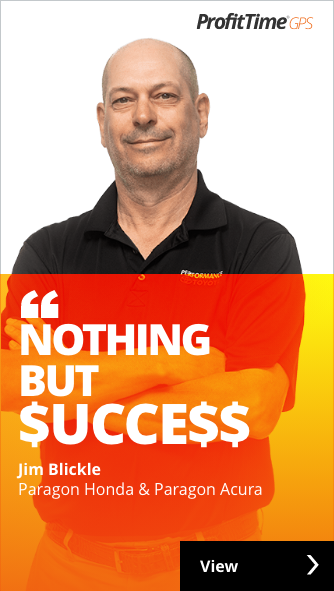ProfitTime in Practice: The Rise (and Risk?) of Third-Party Price Rankings
There’s new concern and conversation about third-party classified sites as dealers begin using Provision ProfitTime.
The dialogue relates to the growing practice among third-party sites to rank or designate a used vehicle’s asking price as great, good, fair or over-priced.
ProfitTime dealers are wondering, if not worrying, about how these practices affect consumer perceptions of their used vehicle pricing, particularly as it relates to Platinum and Gold vehicles.
A quick refresher: As I’ve highlighted previously, once dealers start with ProfitTime, their first order of business is to correct their inventory investment inversion. Using the net profit and ROI insight for each vehicle that ProfitTime provides, dealers will raise the asking prices for Platinum and Gold vehicles, and lower the asking prices for Bronze and Silver vehicles.
Now, ProfitTime dealers worry that, as they raise the asking prices of their Platinum and Gold vehicles, the third-party sites will tell consumers the prices aren’t fair, and the dealer will lose out on a potential deal.
To be sure, I haven’t seen any concrete evidence that dealers are losing deals because of the third-party classified site price rankings and designations.
But I’m disturbed and troubled by how often this topic has been coming up in the closing weeks of 2019. The frequency makes me wonder if dealers are on to something.
Is there a disconnect between the competitive sets and market data dealers use to price their used vehicles, and the competitive sets third-party classified sites use to rank or value the dealer’s asking price for potential buyers?
Unfortunately, I don’t have a good answer.
I would like to believe, however, that the algorithms and formulas the third-party sites use to rank or value a used vehicle’s asking price are based on relevant and valid market data. Further, I would also like to believe that the third-party sites actively seek to balance the interests of the dealers who advertise vehicles on their platforms, and the consumers who use the platforms to find their next vehicle.
But one thing is certain.
I haven’t heard that ProfitTime dealers are having trouble selling their Platinum and Gold vehicles at higher asking prices than these vehicles might have received in the past. In fact, the more common refrain is that dealers are surprised by how much interest their Platinum and Gold vehicles generate in a market at higher asking price points.
I believe this reality owes to a couple factors, which I share with dealers to put their minds at ease about any undue negative influence that may be caused by the rankings and designations third-party classified sites assign to used vehicle prices.
First, I’m not fully convinced that a third party classified site’s price rank or value designation makes or breaks a deal with most used vehicle buyers and shoppers.
To be sure, some buyers and shoppers may see a third-party site’s price rank or value designation and decide, “That’s it. I’m going to buy this car.”
But most consumers, I believe, will take a third-party site’s price rank or value designation as but one reference point on their used vehicle purchase journey.
They will continue to look at other vehicles, and criss-cross the third-party sites and their price rankings and designations, as they affirm for themselves what the right vehicle and right price may be.
I’ll also tell dealers that if they’re worried about the third-party classified site price ranks and designations for their Platinum and Gold vehicles, they should recognize that such indicators can help them as they price their Bronze and Silver vehicles more aggressively to match their respective investment values.
Second, I’ll remind dealers that their Platinum and Gold vehicles don’t need to be sold on price as much as other vehicles. As we’ve discussed in earlier chapters, Platinum and Gold vehicles are “naturals.”
They are vehicles that sales associates have an incentive to sell, because you own the vehicles right and they offer a sizable commissionable gross profit; they have high demand and low supply in the market; and they have strong Retail Sales Volumes.
In other words, your Platinum and Gold vehicles are scarce and sought-after, and their buyers know it. It’s my belief that these buyers are less likely to be influenced by a third-party site’s price rank or value designation, especially if they’ve found the car they really want.
It’s too early to tell whether the practice of third-party classified sites taking it upon themselves to assign a rank or value to a dealer’s used vehicle pricing represents a valid fear and friction point for dealers.
But it’s intriguing to me that this issue has cropped up in earnest as dealers have adopted ProfitTime and become more vehicle-specific and precise in their pricing strategies.
The timing makes me wonder: If ProfitTime didn’t exist, and dealers didn’t have the opportunity to right-size their used vehicle pricing based on each vehicle’s investment value, would the concern about third-party classified site price rankings and designations would have come up at all?
It’s an impossible question to answer, at least for the moment.
That’s why I’m encouraging dealers to pay closer attention to how your third-party classified site partners regard your ProfitTime pricing strategies in the context of their good deal/bad deal designations—and to ask questions if something doesn’t seem fair or right.
The post ProfitTime in Practice: The Rise (and Risk?) of Third-Party Price Rankings appeared first on Dale Pollak.

















